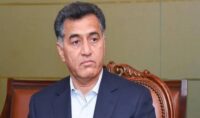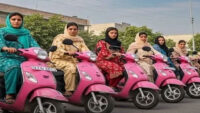While Modi has exposed the weaknesses of the so-called Indian Democracy, now various independence movements are gaining momentum from India’s brutal hegemony to keep them intact as Attot Ang and Akhand Bharat as this concept of Greater India is falling apart more quickly than thought.
A brief Indo-Pak war where India lost control of its Air Space has shown the world that you can be economically strong without numbering your enemy but to win a battle the resolve of a nation is more important which was shown by Pakistan.
Seven Indian States linked through Chicken Neck of 22 KM width were kept aligned with India with brutal force and a lot of people there have suffered at the hands of Indian forces. China has a strong claim over the Zangnan (Arunachal Pradesh) area being South Tibet so we may expect that to become a part of Tibet soon.
One more Indian official in Pakistan declared persona non grata
Israeli army opens fire to intimidate foreign diplomatic delegation in West Bank
Massive turbulence on Delhi-Srinagar flight due to bad weather
For more such Opinions & Blogs, click here.
Similarly, #Khalistan is also on the brink and from the time Indira Gandhi brutally attacked and killed Jarnail Singh Bhandranwala in Golden Temple, it was written on the wall that it’s a matter of time and by killing Sikhs, India can only delay it.
India should worry about Assam and West Bengal now as keeping people together is beyond Hindutva and the BJP of Modi cannot see behind that Hindutva.
And of course, if Trump had not intervened and forced the Ceasefire, Kashmir would have been free by now. So it’s a matter of yet another skirmish between the two.
Air supremacy has shown time and again that forces of millions become sitting ducks if Air Power fails.
United Liberation Front of Assam (ULFA) and Bodoland Movement though suppressed through military operations in the 2000s sentiments of abrogation of the local resources by India are common and India needs to keep a good watch on Paresh Baroah group (ULFA) being suppressed and silent at the moment but they may ignite yet another full scale separatist movement.
After winning military front, Pakistan must focus economic victory: Speakers
Another Pakistani official in India declared persona non grata
NASA Warns Of Massive Solar Storm That Could Trigger Blackouts
India has had several separatist movements since independence, let’s summarize them a little.
MOSTLY they are driven by ethnic, religious, linguistic, or political grievances. While some have been resolved, others remain active or dormant. Here’s an overview of major separatist movements in India:
1. Kashmir (Jammu & Kashmir)
– Demand: Independence or merger with Pakistan.
– Key Groups:
– Hizbul Mujahideen (Islamist group)
– JKLF (Jammu Kashmir Liberation Front – secular, but seeks independence)
– Status:
– Ongoing insurgency since 1948.
– India revoked J&K’s special status (Article 370) in 2019, integrating it more closely into India.
– Militancy persists for independence as India has denied Kashmiris their right to a plebiscite as per various UN Security Council resolutions (47,51,80, 122 and several others including the denial of UNCIP decisions).
President, PM condemn terrorist attack on school bus in Balochistan
Pakistan, China & Afghanistan agree to deepen cooperation on BRI
Pakistan’s envoy to US visits SpaceX aerospace, tech company
2. Punjab (Khalistan Movement)
– Demand: A separate Sikh nation called “Khalistan”.
– Key Groups:
– Babbar Khalsa
– Khalistan Commando Force
– History:
– Peaked in the 1980s-90s (Operation Blue Star, anti-Sikh riots 1984).
– Crushed by Indian security forces by the mid-1990s.
– Current Status:
– Suppressed Militarily/Dormant in India, but some support among the Sikh diaspora (Canada, UK, US).
– Recent tensions (e.g., Amritpal Singh’s arrest, 2023 and killings of Sikh leaders abroad) show lingering sentiments.
International Tea Day being observed today
Khuzdar school bus attack planned in India: ISPR
Suicide blast hits school bus in Khuzdar; four children, two teachers killed
3. Northeast India (Multiple Insurgencies)
A. Nagaland (Naga Insurgency)
– Demand: “Greater Nagalim” (independent Naga state including parts of NE India & Myanmar).
– Key Group: NSCN-IM (National Socialist Council of Nagaland-Isak-Muivah).
– Status:
– Longest-running insurgency in India (since the 1950s).
– Ceasefire since 1997, but peace talks are stalled.
B. Assam (ULFA)
– Demand: Sovereign Assam (now reduced to autonomy demands but any small incidence can trigger a sleeping movement to reignite).
– Status: Most factions in peace talks; hardliners weakened.
Former adviser to Biden Congratulates Gen. Asim Munir on Becoming Field Marshal
Field Marshal dedicates honor to nation, Armed Forces
President, PM, Ministers, CJCSC & services chiefs congratulate COAS on promotion
C. Manipur (Meitei vs. Kuki Conflict)
– Demand: Some Kuki groups want a separate state (“Kukiland”).
– Status: Ethnic violence (2023-present), but not a full separatist movement.
D. Mizoram (MNF)
– Demand: Independence (historically).
– Status: Mizo Accord (1986) ended insurgency; Mizoram now has an uneasy calm but overall remains peaceful.
4. Left-Wing Extremism (Maoist/Naxalite Insurgency)
– Demand: Communist revolution, not full separatism.
– Affected Areas: Chhattisgarh, Jharkhand, Odisha, Andhra Pradesh.
– Key Group: CPI-Maoist.
– Status: Declining but still active in remote areas.
Gen Asim Munir promoted to rank of field marshal
Business community should take advantage of Pakistan’s improved regional position: APP-GREF-PCJCCI
5. Tamil Nadu (Dravidistan Movement – Historical)
– Demand: Separate Dravidian nation (1940s-60s).
– Key Figure: E.V. Ramasamy (Periyar).
– Status: Defunct after linguistic reorganization of states.
6. Other Minor Movements
– Gorkhaland (West Bengal): Demand for a separate state, not independence.
– Bodoland (Assam): Autonomy within India, not secession.
– Kashmiri Pandits: Seek homeland but not separatism.
Why Do These Movements Exist?
1. Historical Grievances (e.g., British-era divisions, post-Partition tensions).
2. Ethnic & Religious Identity (e.g., Sikhs in Punjab, Nagas in NE).
3. Economic Neglect (e.g., NE states feel ignored by Delhi).
4. External Support (Pakistan in Kashmir, China in NE).
Beating Retreat To Resume At India-Pak Border Points In Punjab
Second phase of auction for outdated power plants begins
World Bee Day being observed today
Current Situation (2025)
– Active Conflicts: Hottest is Kashmir, Manipur (ethnic, not separatist), and Maoist zones.
– Dormant/Unresolved: Khalistan (outside India), Mizo insurgency, Dravidistan.
– Peace Talks Ongoing: Nagaland, Assam (ULFA).
Conclusion:
India has managed to suppress or negotiate with most separatist movements, but Kashmir remains the most volatile. The Northeast has been simmering but suppression thru the Military is working at the moment keeping an uneasy calm. Arunachal Pradesh, now Zangnan as named by China is likely to be the next battleground between India and China. This will not be a big war as India neither has the resolve nor the power to contest the disputed region.
NE India may also form a Confederation of seven states to be known as Seven Sister States (SSS of India).
For more such Opinions & Blogs, click here.
Security forces kill 12 terrorists in KP, Balochistan
Pakistan rejects allegations of attempting to target Golden Temple
Pakistani nation has never & will never bow down: DG ISPR
Over 178,000 Afghans Return from Pakistan in 40 Days: UNHCR
Pakistan Imposes 10% Fee on Afghan Transit Goods
Stay tuned to Baaghi TV for more. Download our app for the latest news, updates & interesting content!






